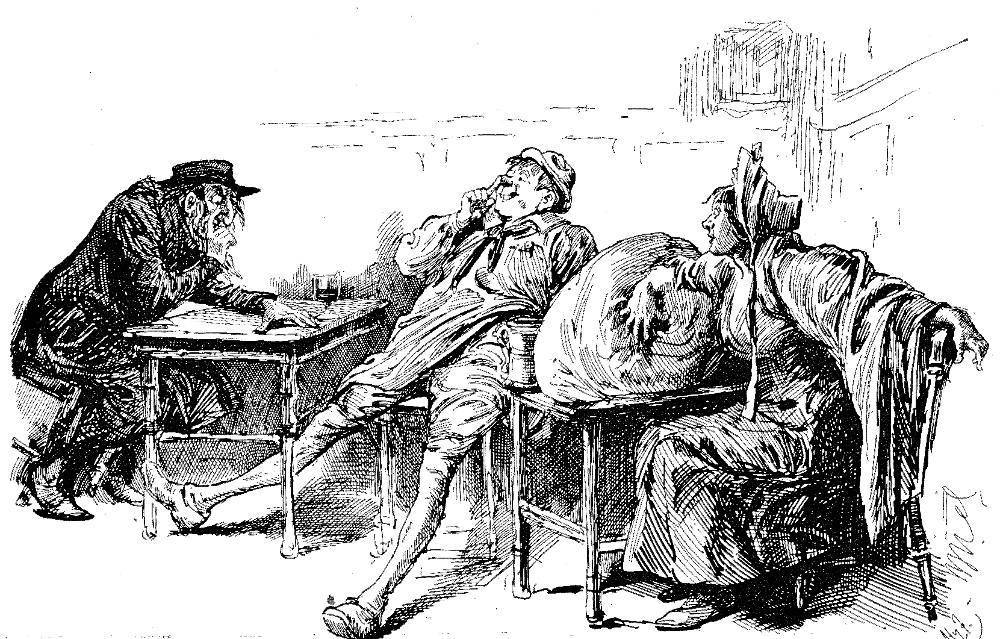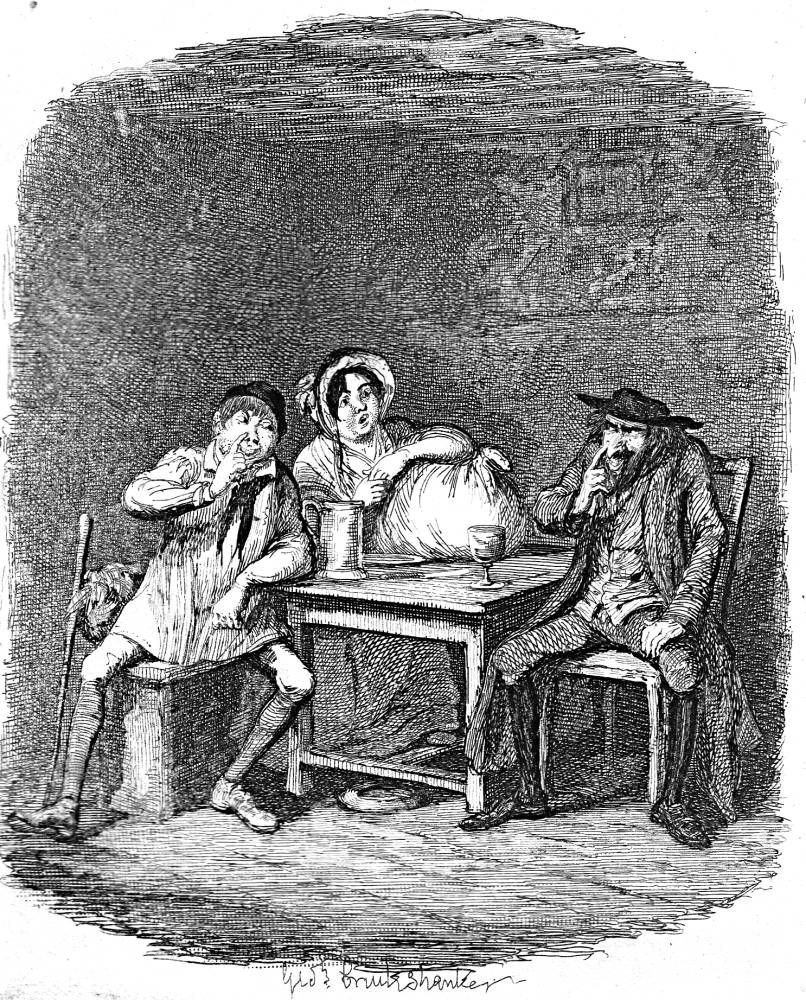
Fagin and Noah understand each other by Harry Furniss. Dickens's The Adventures of Oliver Twist, Charles Dickens Library Edition, facing III, 320. Lithograph from pen-and-ink, 9 cm by 14 cm, vignetted.
The Charles Dickens Library Edition’s Long Caption
The Jew followed up this remark by striking the side of his nose with his right forefinger, — a gesture which Noah attempted to imitate, though not with complete success, in consequence of his own nose not being large enough for the purpose.[325]
Passage Illustrated
"A pleasant night, sir, but cool for the time of year," said Fagin, rubbing his hands. "From the country, I see, sir?"
How do yer see that?" asked Noah Claypole.
"We have not so much dust as that in London," replied Fagin, pointing from Noah's shoes to those of his companion, and from them to the two bundles.
"Yer a sharp feller," said Noah. "Ha! ha! only hear that, Charlotte!"
"Why, one need be sharp in this town, my dear," replied the Jew, sinking his voice to a confidential whisper; "and that's the truth."
Fagin followed up this remark by striking the side of his nose with his right forefinger, — a gesture which Noah attempted to imitate, though not with complete success, in consequence of his own nose not being large enough for the purpose. However, Mr. Fagin seemed to interpret the endeavour as expressing a perfect coincidence with his opinion, and put about the liquor which Barney reappeared with, in a very friendly manner. [Chapter 42, "An old Acquaintance of Oliver's, exhibiting decided marks of Genius, becomes a public Character in the Metropolis," 241]
Commentary
Although a relatively minor character, in Dickens's text Noah has a distinctive drawl ('yer") that renders him instantly recognizable, just as Cruikshank has given him a unique form (long, thin legs and a head like a globe with a fringe of hair obscuring his forehead) that renders him unmistakable in his four appearances, three of which are with Charlotte, the vacuous housemaid infatuated with his irreverent and exploitative personality. However, in Furniss's version Charlotte seems much more alert and much more astutely following the conversation than her drunken companion.
In the original serial illustrations, Oliver now disappears, only to re-emerge in the so-called "cancelled illustration" — Oliver and His Family — The Fireside Plate — and the plate which Dickens requested to replace it, Rose Maylie and Oliver — The Church Plate. In the Household Edition, James Mahoney does not realise the meeting of the runaways and the master criminal, although he does show the arrival of Noah and Clarlotte on the outskirts of London in "Look there! Those are the lights of London" in Chapter 42 before shifting the reader's attention momentarily from the doomed relationship between Nancy and Sikes to the Dodger's being sentenced to transportation in "What is this?" inquired one of the magistrates. — "A pick-pocketing case, Your Worship" in Chapter 43, with Claypole, a new hire in the gang and therefore unknown to the police (disguised as a countryman in a linen smock-frock and holding a carter's whip) observes the proceedings on behalf of Fagin. In contrast, Frederic W. Pailthorpe's in his 1886 series of twenty-one engravings moves directly to Sikes's grisly crime in The Foul Deed, not actually showig the scene in which Nancy rendezvous with Rose Maylie and Mr. Brownlow at London Bridge.
The Furniss lithograph, which is a reworking of The Jew & Morris Both begin to understand each other (see below; Part 19, November 1838), realizes another fateful meeting, that of Oliver's old nemesis, the spindly-legged Noah (who has robbed Sowerberry's till and fled to London with the Sowerberrys' maid, Charlotte) and Fagin, who has made his temporary headquarters at the disreputable public house known as The Three Cripples. Cruikshank depicted the moment when Noah believes he has met a kindred spirit, a knowing denizen of the metropolis — just prior to Noah's becoming highly apprehensive when by chance Fagin asserts that making drinking such a beverage will require augmenting one's income by such illegal expedients as robbing the master's till. Furniss's Fagin, in contrast, by his quizzical look implies that he recognizes Noah, already disguised in a carter's smock-frock, as a cowardly braggart and a pompous fool, whose proclivities have only been exaggerated by the contents of the enormous tankard beside him in Chapter 42.
In terms of Furniss's characterisations, Noah is the least consistent with other illustrators' interpretations: although this Noah has the comic, spindly legs that are a consequence of his poor diet growing up, his hat hides the hairstyle given him by Cruikshank, and the thick neck seems odd — the emphasized, pointed red nose is, one presumes, a cue to his alcoholism. He is, indeed, as in the Kerslake and Robson Edition of 1886, illustrated by Pailthorpe, namely Noah running for Mr. Bumble. Already, he has abandoned his yellow smalls as he has abandoned his former identity to become "Morris Bolter" (as Fagin has nicknamed him, a pseudonym that implies Noah's being an apprentice who has "run off" from his master Mudfog) in an oversized linen smock-frock that exaggerates his girth.
Noah Claypole in Illustrations, 1837-1910



Left: Sol Eytinge, Junior's Noah and Charlotte (1867). Centre: Cruikshank's illustration The Jew & Morris Both begin to understand each other (Part 19, November 1838). Right: Kyd's original watercolour study Noah Claypole (c. 1900).

Above: Mahoney's 1871 engraving of the runaways from Mudfog, approaching the outskirts of London, Look there! Those are the lights of London.".
Scanned image and text by Philip V. Allingham. [You may use this image without prior permission for any scholarly or educational purpose as long as you (1) credit the person who scanned the image and (2) link your document to this URL in a web document or cite the Victorian Web in a print one.].
Bibliography
Darley, Felix Octavius Carr. Character Sketches from Dickens. Philadelphia: Porter and Coates, 1888.
Davis, Paul. Charles Dickens A to Z: The Essential Reference to His Life and Work. New York: Facts On File, 1998.
Dickens, Charles. The Adventures of Oliver Twist; or, The Parish Boy's Progress. Illustrated by George Cruikshank. London: Bradbury and Evans; Chapman and Hall, 1838; rpt. with revisions 1846.
_____. Oliver Twist. Works of Charles Dickens. Household Edition. 55 vols. Illustrated by F. O. C. Darley and John Gilbert. New York: Sheldon and Co., 1865.
_____. Oliver Twist. Works of Charles Dickens. Diamond Edition. 14 vols. Illustrated by Sol Eytinge, Jr. Boston: Ticknor and Fields, 1867.
_____. Oliver Twist. Works of Charles Dickens. Household Edition. 22 vols. Illustrated by James Mahoney. London: Chapman and Hall, 1871. Vol. I.
_____. The Adventures of Oliver Twist. Works of Charles Dickens. Charles Dickens Library Edition. 18 vols. Illustrated by Harry Furniss. London: Educational Book Company, 1910. Vol. III.
_____. The Adventures of Oliver Twist. Works of Charles Dickens. The Waverley Edition. Illustrated by Charles Pears. London: Waverley, 1912.
_____.The Letters of Charles Dickens. Ed. Graham Storey, Kathleen Tillotson, and Angus Eassone. The Pilgrim Edition. Oxford: Clarendon, 1965. Vol. I (1820-1839).
Forster, John. "Oliver Twist 1838." The Life of Charles Dickens. Ed. B. W. Matz. The Memorial Edition. 2 vols. Philadelphia: J. B. Lippincott, 1911. Vol. I, Book 2, Chapter 3.
Jordan, John O. "The Purloined Hankerchief." Chapter 3, "A Critical Selection." Readings on Charles Dickens "Oliver Twist.". Greenhaven Press Literary Companion to British Literature. Originally in Dickens Studies Annual, 1989. San Diego, CA: Greenhaven, 2001, 167-83.
Kyd (Clayton J. Clarke). Characters from Dickens. Nottingham: John Player & Sons, 1910.
Lankford, William T. "The Evolving Form of Oliver Twist." Readings on Charles Dickens's "Oliver Twist". Greenhaven Press Literary Companion to British Literature. Originally in The Publications of the Modern Language Association, January 1978. San Diego, CA: Greenhaven, 2001, 76-90.
Pailthorpe, Frderick W. (Illustrator). Charles Dickens's Oliver Twist. London: Robson & Kerslake, 1886. Set No. 118 (coloured) of 200 sets of proof impressions.
Vann, J. Don. "Oliver Twist." Victorian Novels in Serial. New York: The Modern Language Association, 1985, 62-63.
Created 3 March 2015
Last modified 1 March 2020